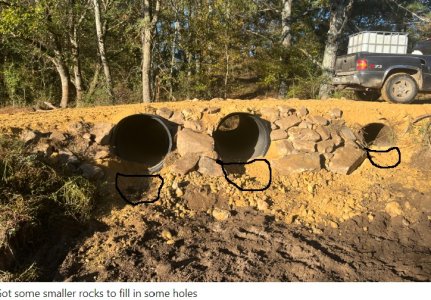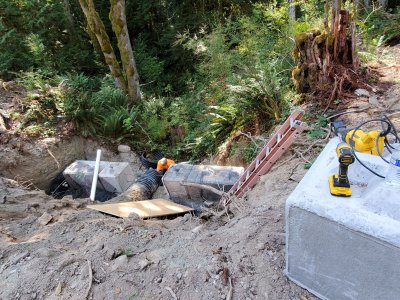What I've seen happen multiple times, is the circled areas wash out into a deep hole as the water pours out the end of the pipes. As the hole gets deeper, the sides cave in and the edge of the roadway follows.. Some
BIG flat rocks right under where the water exits can help stop that washing.
I never used 'em but could NRCS help you with this kind of project?
NOT criticising at all, but to me, it 'looks' like you would need more cover on the top. 'Looks' thin if it were on my old place.
View attachment 35930
There is a possibility, if there isn't plenty of top cover or what is called an anti-seep collar, that a build up of water on the back side will either cause seepage and washout on a new install or, if debris builds water and pressure on the backside, the whole pipe (even tho it's ribbbed) will go sliding out. I had it happen on a 24" ribbed pipe that hadn't been in the ground but a couple of weeks and not driven over much yet when a big rain came, flotsam plugged the back side and I watched as it went sliding down the usually dry creek. The ribs help and it isn't as much problem as it would be with slick PVC but it does still happen with ribbed pipe.
I learned, to use the anti seep collar. It helps hold the pipe in place too. You can make 'em yourself and it doesn't have to stick up above the pipe as much as this one does:
View attachment 35931
 paid off , bat wing bush hog purchased , creek crossing redone. (Pics tomorrow). With the good price calves have been bringing we have been able to get some things done . Creek crossing had been gradually getting smaller/ narrower. Dug out since creek is dry and concrete tiles replaced with 2 twenty ft 36 inch plastic ones . Couple loads of chert on the pipes to drive over .
paid off , bat wing bush hog purchased , creek crossing redone. (Pics tomorrow). With the good price calves have been bringing we have been able to get some things done . Creek crossing had been gradually getting smaller/ narrower. Dug out since creek is dry and concrete tiles replaced with 2 twenty ft 36 inch plastic ones . Couple loads of chert on the pipes to drive over .










